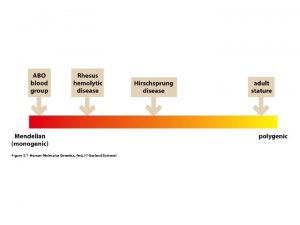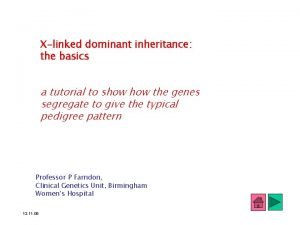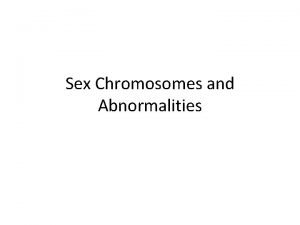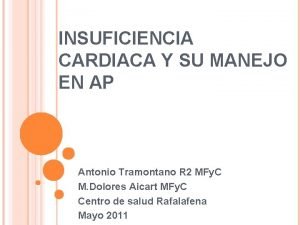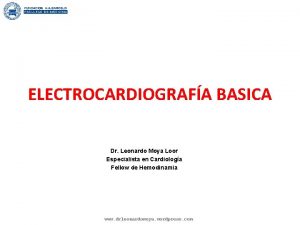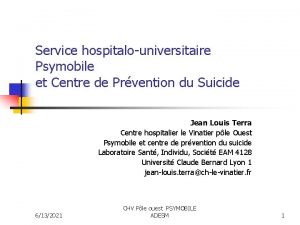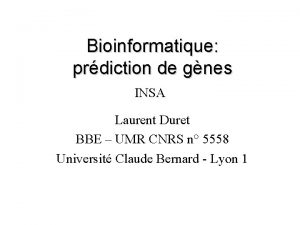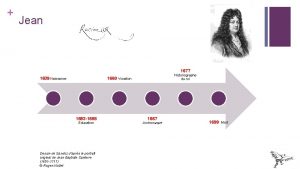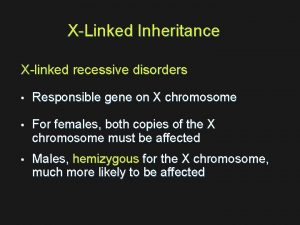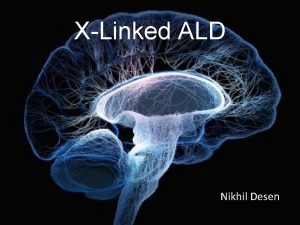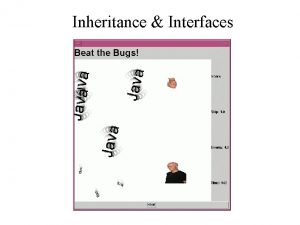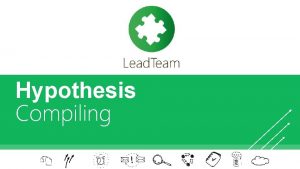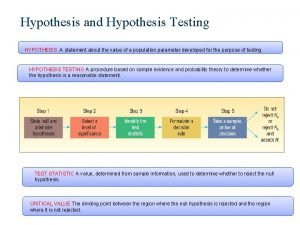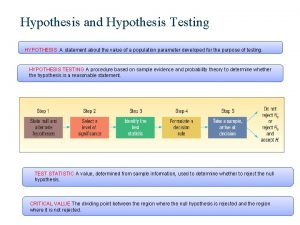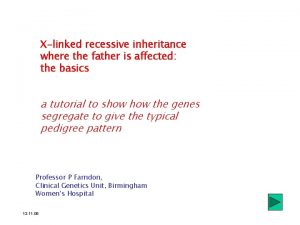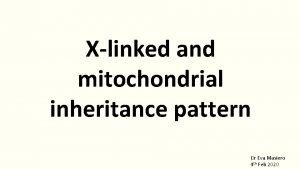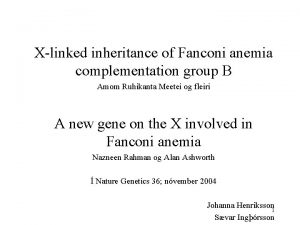Xlinked inheritance Oliver Quarrell Lecture Plan Lyon hypothesis











































- Slides: 43

X-linked inheritance Oliver Quarrell

Lecture Plan • • • Lyon hypothesis X linked recessive males do not reproduce X linked recessive males reproduce X linked dominant lethal in males Main example will be Duchenne muscular dystrophy • Options for a female carrier



Sex-linked inheritance • Genes carried on the X chromosome. • More males than females affected. • Females are carriers. 50% sons affected. 50% daughters are carriers. • All daughters of affected males are carriers. • None of the offspring of affected males have the disorder. • Possibility of new mutations. • Gonadal mosaicism may occur. • Influenced by X inactivation.

Lyon hypothesis • • X-chromosome inactivation Occurs early in embryogenesis Random process Once occurred cells from subsequent cell divisions inactivate the same Xchromosome • There are some rare mechanisms which result in non-random X-inactivation

X-Linked Inheritance X Y X X

Muscular dystrophy • “please see this lady who has a relative affected by muscular dystrophy” • WHICH ONE • Beware of umbrella terms • In this lecture we are focusuing on the xlinked forms Duchenne and Becker • Comment on NHS choices website

Scenario • A lady presents to ante-natal clinic • Her brother had Duchenne muscular dystrophy • Her uncle died of muscular dystrophy age 21 he was in wheelchair. • Her mother must be a carrier

Summary of clinical problem

www. neuro. wustl. edu/. . . / pathol/dmdpath. htm

www. neuro. wustl. edu/. . . / pathol/dmdpath. htm

www. mja. com. au/. . . / byr 10494_fm. html


Gower’s Sign • Proximal muscle weakness • Have to climb up legs

Duchenne Muscular dystrophy • • • Affects males May have delayed walking or running Progressive weakness – waddling gait Treatment steroids and later ventilatory support Wheelchair Die of respiratory failure Do not reproduce Raised creatine kinase muscle enzyme 70% deletion in dystrophin gene

What is the chance of an affected son?

1 in 2 chance she is a carrier

1 in 2 chance she is a carrier 1 in 4 chance of affected male

Management • Normal CK reduces chance of her being carrier but does not exclude it LYONISATION • Identify deletion in brother test pregnant lady • Look for point mutation • No deletion or point mutation found do a linkage analysis

New mutations • Males do not reproduce • To maintain prevalence in population need new mutations • In an isolated case 1/3 cases are new mutations • Consider an isolated case


Clinical Problem • May be a new mutation • Mother may be a carrier • May be gonadal mosaicism • Sister may or may not be a carrier • Daughter may or may not be a carrier

Management • • Normal CK of limited value 70% chance of identifying deletion in boy Rises to over 90% point muations If mother not a carrier cannot exclude gonadal mosaicism • Residual risk to daughter

Deletion absent Deletion present May be gonadal mosaicism No need to test sister But offer carrier test to daughter when she is 16 +

Primordial germ cell Egg

Deletion present Mother is a carrier have to offer to test mother and sister Offer carrier test to daughter when she is 16 +

New scenario daughter is a carrier. What are her options? Deletion present

Options for a carrier female • Not have any children • Accept the risk and have children • Have pre-natal diagnosis (PND) and consider TOP of affected male fetus • Consider pre-implantation genetic diagnosis PGD

Prenatal diagnosis • Option of free fetal DNA at 9 weeks • Some genetic material from the fetus circulates in the mother blood. • If Y chromosome material assume it is male • If no Y chromosome material assume it is female • Error rate 4 cases in 1000

Invasive test • • Chorion biopsy From 11 weeks Take sample from placental bed Risk of misc ~ 1 - 2% • Can do an amniocentesis but from 15 weeks and have to grow the cells • Risk misc ~1%

Chorion Biopsy


Success rate at outset 20% Success rate at embryo transfer ~30%

What happens if male can reproduce • Becker Muscular dystrophy • Haemophilia A or B

www. neuro. wustl. edu/. . . / pathol/dmdpath. htm


X-Linked Inheritance X X Y X C C C

X-linked dominant • What happens to females if the condition is X-linked dominant?

What happens if the mutation is extremely deleterious • X-linked dominant lethal in males • Males die in utero • Females survive because they are mosaics

X chromosome and disease in females DMD Most carriers Normal Fragile X Affected females Intellectual impairment IP Retts Lethal in most males

Incontinentia Pigmenti • X-linked dominant lethal in males • Can see the Lyonisation

Sex-linked inheritance • Genes carried on the X chromosome. • More males than females affected. • Females are carriers. 50% sons affected. 50% daughters are carriers. • All daughters of affected males are carriers. • None of the offspring of affected males have the disorder. • Possibility of new mutations. • Gonadal mosaicism may occur. • Influenced by X inactivation.
 Xlinked pedigree
Xlinked pedigree Xyx syndrome
Xyx syndrome Xlinked traits
Xlinked traits Lyon hypothesis
Lyon hypothesis Gonadal dysgenesis
Gonadal dysgenesis 01:640:244 lecture notes - lecture 15: plat, idah, farad
01:640:244 lecture notes - lecture 15: plat, idah, farad Null hypothesis biology
Null hypothesis biology Null and alternative hypothesis statistics
Null and alternative hypothesis statistics Null hypothesis examples
Null hypothesis examples Protoplanet hypothesis weakness
Protoplanet hypothesis weakness Tobi lyon
Tobi lyon Lvh criteria cornell
Lvh criteria cornell Mur peint lyon
Mur peint lyon Indice de sokolow lyon
Indice de sokolow lyon Sağ ventrikül hipertrofisi ekg bulguları
Sağ ventrikül hipertrofisi ekg bulguları Gras savoye collectivités locales
Gras savoye collectivités locales Eje ecg
Eje ecg En covoit grand lyon
En covoit grand lyon Quartier aligre gare de lyon
Quartier aligre gare de lyon Where i'm from by george ella lyon
Where i'm from by george ella lyon Master sciences du médicament lyon
Master sciences du médicament lyon Sex industry
Sex industry Psymobile
Psymobile Ciell2 lyon
Ciell2 lyon Dr sophie galand
Dr sophie galand Institut national des sciences appliquees de lyon founded
Institut national des sciences appliquees de lyon founded Maria lyon
Maria lyon Laurent duret lyon
Laurent duret lyon Cio lyon nord
Cio lyon nord George ella lyon where i'm from
George ella lyon where i'm from Where i’m from” by george ella lyon
Where i’m from” by george ella lyon Dr milena lyon
Dr milena lyon Claroline université lyon 1
Claroline université lyon 1 Seocamp lyon
Seocamp lyon Webconvergence lyon
Webconvergence lyon Ecole doctorale chimie lyon
Ecole doctorale chimie lyon 40 allée de fontenay lyon
40 allée de fontenay lyon Sclérose en plaque
Sclérose en plaque Hls iso
Hls iso Contract
Contract Ikebana lyon
Ikebana lyon Lyon france
Lyon france Services euménides lyon
Services euménides lyon Ucb lyon 1
Ucb lyon 1
